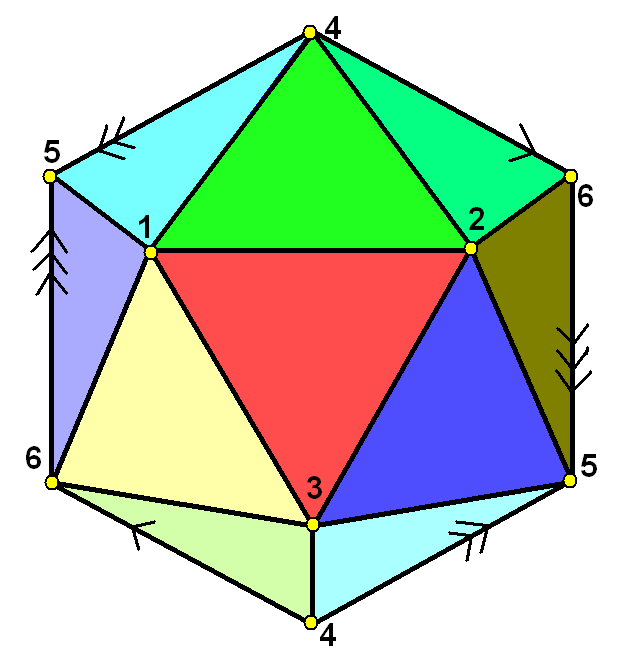|
Great Dodecahemicosahedron
In geometry, the great dodecahemicosahedron (or great dodecahemiicosahedron) is a nonconvex uniform polyhedron, indexed as U65. It has 22 faces (12 pentagons and 10 hexagons), 60 edges, and 30 vertices. Its vertex figure is a crossed quadrilateral. It is a hemipolyhedron with ten hexagonal faces passing through the model center. Related polyhedra Its convex hull is the icosidodecahedron. It also shares its edge arrangement with the dodecadodecahedron (having the pentagonal faces in common), and with the small dodecahemicosahedron (having the hexagonal faces in common). Great dodecahemicosacron The great dodecahemicosacron is the dual of the great dodecahemicosahedron, and is one of nine dual hemipolyhedra. It appears visually indistinct from the small dodecahemicosacron. Since the hemipolyhedra have faces passing through the center, the dual figures have corresponding vertices at infinity; properly, on the real projective plane at infinity. In Magnus Wenninger ... [...More Info...] [...Related Items...] OR: [Wikipedia] [Google] [Baidu] |
Icosidodecahedron
In geometry, an icosidodecahedron or pentagonal gyrobirotunda is a polyhedron with twenty (''icosi-'') triangular faces and twelve (''dodeca-'') pentagonal faces. An icosidodecahedron has 30 identical Vertex (geometry), vertices, with two triangles and two pentagons meeting at each, and 60 identical edges, each separating a triangle from a pentagon. As such, it is one of the Archimedean solids and more particularly, a quasiregular polyhedron. Construction One way to construct the icosidodecahedron is to start with two pentagonal rotunda by attaching them to their bases. These rotundas cover their decagonal base so that the resulting polyhedron has 32 faces, 30 vertices, and 60 edges. This construction is similar to one of the Johnson solids, the pentagonal orthobirotunda. The difference is that the icosidodecahedron is constructed by twisting its rotundas by 36°, a process known as gyration, resulting in the pentagonal face connecting to the triangular one. The icosidodecahedr ... [...More Info...] [...Related Items...] OR: [Wikipedia] [Google] [Baidu] |
Hemi-icosahedron
In geometry, a hemi-icosahedron is an abstract polytope, abstract regular polyhedron, containing half the faces of a regular icosahedron. It can be realized as a projective polyhedron (a tessellation of the real projective plane by 10 triangles), which can be visualized by constructing the projective plane as a wikt:hemisphere, hemisphere where opposite points along the boundary are connected and dividing the hemisphere into three equal parts. Geometry It has 10 triangular faces, 15 edges, and 6 vertices. It is also related to the nonconvex uniform polyhedron, the tetrahemihexahedron, which could be topologically identical to the hemi-icosahedron if each of the 3 square faces were divided into two triangles. Graphs It can be represented symmetrically on faces, and vertices as Schlegel diagrams: The complete graph K6 It has the same vertices and edges as the 5-dimensional 5-simplex which has a complete graph of edges, but only contains half of the (20) faces. From the po ... [...More Info...] [...Related Items...] OR: [Wikipedia] [Google] [Baidu] |
List Of Uniform Polyhedra
In geometry, a uniform polyhedron is a polyhedron which has regular polygons as faces and is vertex-transitive ( transitive on its vertices, isogonal, i.e. there is an isometry mapping any vertex onto any other). It follows that all vertices are congruent, and the polyhedron has a high degree of reflectional and rotational symmetry. Uniform polyhedra can be divided between convex forms with convex regular polygon faces and star forms. Star forms have either regular star polygon faces or vertex figures or both. This list includes these: * all 75 nonprismatic uniform polyhedra; * a few representatives of the infinite sets of prisms and antiprisms; * one degenerate polyhedron, Skilling's figure with overlapping edges. It was proven in that there are only 75 uniform polyhedra other than the infinite families of prisms and antiprisms. John Skilling discovered an overlooked degenerate example, by relaxing the condition that only two faces may meet at an edge. This is a degene ... [...More Info...] [...Related Items...] OR: [Wikipedia] [Google] [Baidu] |
Stellation
In geometry, stellation is the process of extending a polygon in two dimensions, a polyhedron in three dimensions, or, in general, a polytope in ''n'' dimensions to form a new figure. Starting with an original figure, the process extends specific elements such as its edges or face planes, usually in a symmetrical way, until they meet each other again to form the closed boundary of a new figure. The new figure is a stellation of the original. The word ''stellation'' comes from the Latin ''stellātus'', "starred", which in turn comes from the Latin ''stella'', "star". Stellation is the reciprocal or dual process to '' faceting''. Kepler's definition In 1619 Kepler defined stellation for polygons and polyhedra as the process of extending edges or faces until they meet to form a new polygon or polyhedron. He stellated the regular dodecahedron to obtain two regular star polyhedra, the small stellated dodecahedron and the great stellated dodecahedron. He also stellated the regular oct ... [...More Info...] [...Related Items...] OR: [Wikipedia] [Google] [Baidu] |
Prism (geometry)
In geometry, a prism is a polyhedron comprising an polygon Base (geometry), base, a second base which is a Translation (geometry), translated copy (rigidly moved without rotation) of the first, and other Face (geometry), faces, necessarily all parallelograms, joining corresponding sides of the two bases. All Cross section (geometry), cross-sections parallel to the bases are translations of the bases. Prisms are named after their bases, e.g. a prism with a pentagonal base is called a pentagonal prism. Prisms are a subclass of prismatoids. Like many basic geometric terms, the word ''prism'' () was first used in Euclid's Elements, Euclid's ''Elements''. Euclid defined the term in Book XI as "a solid figure contained by two opposite, equal and parallel planes, while the rest are parallelograms". However, this definition has been criticized for not being specific enough in regard to the nature of the bases (a cause of some confusion amongst generations of later geometry writers). ... [...More Info...] [...Related Items...] OR: [Wikipedia] [Google] [Baidu] |
Magnus Wenninger
Father Magnus J. Wenninger OSB (October 31, 1919Banchoff (2002)– February 17, 2017) was an American mathematician who worked on constructing polyhedron models, and wrote the first book on their construction. Early life and education Born to German immigrants in Park Falls, Wisconsin, Joseph Wenninger always knew he was going to be a priest. From an early age, it was understood that his brother Heinie would take after their father and become a baker, and that Joe, as he was then known, would go into the priesthood. When Wenninger was thirteen, after graduating from the parochial school in Park Falls, Wisconsin, his parents saw an advertisement in the German newspaper ''Der Wanderer'' that would help to shape the rest of his life. The ad was for a preparatory school in Collegeville, Minnesota, associated with the Benedictine St. John's University. While admitting to feeling homesick at first, Wenninger quickly made friends and, after a year, knew that this was where he nee ... [...More Info...] [...Related Items...] OR: [Wikipedia] [Google] [Baidu] |
Real Projective Plane
In mathematics, the real projective plane, denoted or , is a two-dimensional projective space, similar to the familiar Euclidean plane in many respects but without the concepts of distance, circles, angle measure, or parallelism. It is the setting for planar projective geometry, in which the relationships between objects are not considered to change under projective transformations. The name ''projective'' comes from perspective drawing: projecting an image from one plane onto another as viewed from a point outside either plane, for example by photographing a flat painting from an oblique angle, is a projective transformation. The fundamental objects in the projective plane are points and straight lines, and as in Euclidean geometry, every pair of points determines a unique line passing through both, but unlike in the Euclidean case in projective geometry every pair of lines also determines a unique point at their intersection (in Euclidean geometry, parallel lines never in ... [...More Info...] [...Related Items...] OR: [Wikipedia] [Google] [Baidu] |
Vertex (geometry)
In geometry, a vertex (: vertices or vertexes), also called a corner, is a point (geometry), point where two or more curves, line (geometry), lines, or line segments Tangency, meet or Intersection (geometry), intersect. For example, the point where two lines meet to form an angle and the point where edge (geometry), edges of polygons and polyhedron, polyhedra meet are vertices. Definition Of an angle The ''vertex'' of an angle is the point where two Line (mathematics)#Ray, rays begin or meet, where two line segments join or meet, where two lines intersect (cross), or any appropriate combination of rays, segments, and lines that result in two straight "sides" meeting at one place. :(3 vols.): (vol. 1), (vol. 2), (vol. 3). Of a polytope A vertex is a corner point of a polygon, polyhedron, or other higher-dimensional polytope, formed by the intersection (Euclidean geometry), intersection of Edge (geometry), edges, face (geometry), faces or facets of the object. In a polygon, a ... [...More Info...] [...Related Items...] OR: [Wikipedia] [Google] [Baidu] |
Dual Polyhedron
In geometry, every polyhedron is associated with a second dual structure, where the vertices of one correspond to the faces of the other, and the edges between pairs of vertices of one correspond to the edges between pairs of faces of the other. Such dual figures remain combinatorial or abstract polyhedra, but not all can also be constructed as geometric polyhedra. Starting with any given polyhedron, the dual of its dual is the original polyhedron. Duality preserves the symmetries of a polyhedron. Therefore, for many classes of polyhedra defined by their symmetries, the duals belong to a corresponding symmetry class. For example, the regular polyhedrathe (convex) Platonic solids and (star) Kepler–Poinsot polyhedraform dual pairs, where the regular tetrahedron is self-dual. The dual of an isogonal polyhedron (one in which any two vertices are equivalent under symmetries of the polyhedron) is an isohedral polyhedron (one in which any two faces are equivalent .., and vice ... [...More Info...] [...Related Items...] OR: [Wikipedia] [Google] [Baidu] |
Face (geometry)
In solid geometry, a face is a flat surface (a Plane (geometry), planar region (mathematics), region) that forms part of the boundary of a solid object. For example, a cube has six faces in this sense. In more modern treatments of the geometry of polyhedra and higher-dimensional polytopes, a "face" is defined in such a way that it may have any dimension. The vertices, edges, and (2-dimensional) faces of a polyhedron are all faces in this more general sense. Polygonal face In elementary geometry, a face is a polygon on the boundary of a polyhedron. (Here a "polygon" should be viewed as including the 2-dimensional region inside it.) Other names for a polygonal face include polyhedron side and Euclidean plane ''tessellation, tile''. For example, any of the six square (geometry), squares that bound a cube is a face of the cube. Sometimes "face" is also used to refer to the 2-dimensional features of a 4-polytope. With this meaning, the 4-dimensional tesseract has 24 square faces, each ... [...More Info...] [...Related Items...] OR: [Wikipedia] [Google] [Baidu] |
Small Dodecahemicosacron
In geometry, the small dodecahemicosacron is the dual of the small dodecahemicosahedron, and is one of nine dual hemipolyhedra. It appears visually indistinct from the great dodecahemicosacron. Since the hemipolyhedra have faces passing through the center, the dual figures have corresponding vertices at infinity; properly, on the real projective plane at infinity. In Magnus Wenninger's ''Dual Models'', they are represented with intersecting prisms, each extending in both directions to the same vertex at infinity, in order to maintain symmetry. In practice the model prisms are cut off at a certain point that is convenient for the maker. Wenninger suggested these figures are members of a new class of stellation figures, called ''stellation to infinity''. However, he also suggested that strictly speaking they are not polyhedra because their construction does not conform to the usual definitions. Since the small dodecahemicosahedron has ten hexagonal faces passing through the mode ... [...More Info...] [...Related Items...] OR: [Wikipedia] [Google] [Baidu] |





